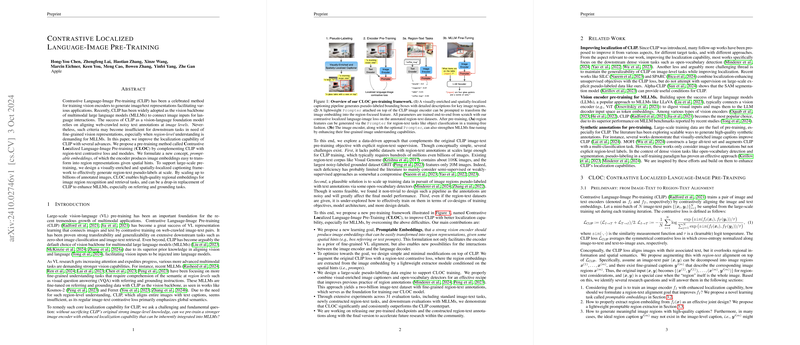An Analysis of Contrastive Localized Language-Image Pre-Training
The paper introduces a novel framework named Contrastive Localized Language-Image Pre-Training (CLOC), an advancement of the traditional Contrastive Language-Image Pre-training (CLIP) methodology. CLIP has been instrumental in bridging vision and language by training encoders on image-text pairs, but its limitations manifest when fine-grained vision understanding is necessary, particularly in region-level tasks and multimodal LLMs (MLLMs). CLOC addresses these shortcomings by enhancing CLIP's localization capability through several strategies.
Key Contributions
CLOC presents several significant contributions to vision-language pre-training:
- Promptable Embeddings: The paper introduces the concept of promptable embeddings. The idea is to train vision encoders to produce image embeddings that are easily convertible into region-specific representations with spatial cues. This facilitates a more nuanced vision-language alignment.
- Augmented Loss Function: By integrating a region-text contrastive loss into the CLIP framework, CLOC seeks to enhance the encoder's regional understanding without diminishing its global semantic knowledge.
- Dataset Expansion: The authors have developed a scalable data engine called Visually-Enriched and Spatially-Localized captioning (VESL). This engine synthesizes image concepts and spatially localized captions, generating a large-scale dataset crucial for training CLOC.
- Comprehensive Evaluation: Through exhaustive experiments over 31 tasks, CLOC demonstrates superior performance compared to traditional CLIP in both standard image-text and novel region-text tasks.
Technical Approach
The CLOC methodology builds upon CLIP's base framework by introducing the notion of contrastive learning at a localized level. The architecture incorporates a lightweight 'Prompter' module to conditionally transform image embeddings based on spatial hints. This transformation is critical in generating region-specific features that are more adept at handling tasks requiring detailed spatial semantic understanding.
The paper provides an exploration of the data requirements necessary for such pre-training. Leveraging VESL, CLOC constructs a dataset comprising billions of region-text pairs. This approach addresses the scarcity of large-scale region-text annotations, traditionally a bottleneck in region-level contrastive learning.
Evaluation and Implications
The evaluations are thorough and varied, spanning zero-shot image classification, retrieval tasks, and region-specific evaluations like object recognition and region-text retrieval. CLOC consistently outperforms CLIP, particularly highlighting its advancements in fine-grained image tasks. The results underscore CLOC’s capability as a potential foundational model for MLLMs, enhancing their performance in referring and grounding tasks.
The implications of this research are substantial. Practically, the enhanced vision-language alignment through localized understanding can significantly improve applications in areas requiring detailed image analysis and interpretation. Theoretically, CLOC sets a precedent for refining foundation models by integrating localized learning objectives, which could inspire future innovations in pre-training methodologies.
Future Directions
The paper gestures towards several avenues for future work. Extending promptable embeddings to accept various prompt types beyond simple bounding boxes—such as free-form text or points—could further optimize region-specific understanding. Additionally, refining the VESL pipeline to generate higher-quality annotations may result in even better model performance without significant computational overhead increases.
In conclusion, CLOC represents a meaningful enhancement to the CLIP framework by successfully introducing and training for region-level vision-language pre-training. This method promises improvements in the granularity of visual understanding, which is crucial for advancing AI applications in complex visual environments.
